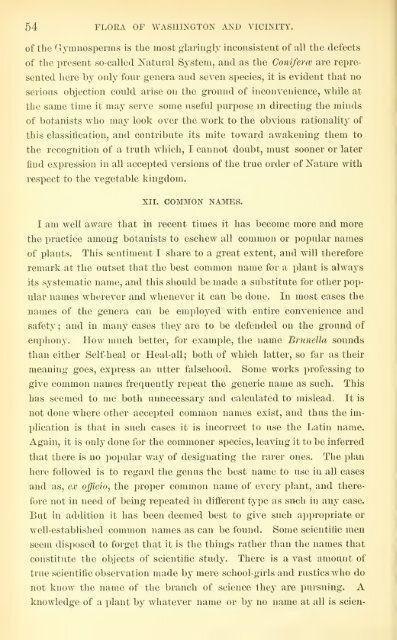Bulletin - United States National Museum - Smithsonian Institution
Bulletin - United States National Museum - Smithsonian Institution
Bulletin - United States National Museum - Smithsonian Institution
You also want an ePaper? Increase the reach of your titles
YUMPU automatically turns print PDFs into web optimized ePapers that Google loves.
64 FLORA OF WASHINGTON AND VICINITY.<br />
of the Gymnosperins is the most glaringly inconsistent of all the defects<br />
of the present so-called Natural System, and as the Goniferw are repre-<br />
sented here by only four genera and seven species, it is evident that no<br />
serious objection could arise on the ground of inconvenience, while at<br />
the same time it may serve some useful purpose m directing the minds<br />
of botanists who may look over the work to the ob^dous rationality of<br />
this classitication, and contribute its mite toward awakening them to<br />
the recognition of a truth which, I cannot doubt, must sooner or later<br />
find expression in all accepted versions of the true order of Nature with<br />
respect to the vegetable kingdom.<br />
XII. COMMON NAMES.<br />
I am well aware that in recent times it has become more and more<br />
the practice among botanists to eschew all common or popular names<br />
of plants. This sentiment I share to a great extent, and will therefore<br />
remark at the outset that the best common name for a plant is always<br />
its systematic name, and this should be made a substitute for other pop-<br />
ular names wherever and whenever it can be done. In most cases the<br />
names of the genera can be emi^loyed with entire convenience and<br />
safety; and in many cases they are to be defended on the ground of<br />
euphony. How much better, for example, the name Brunella sounds<br />
than either Self-heal or Heal-all; both of which latter, so far as their<br />
meaning goes, express an utter falsehood. Some works professing to<br />
give common names frequently repeat the generic name as such. This<br />
has seemed to me both unnecessary and calculated to mislead. It is<br />
not done where other accepted common names exist, and thus the im-<br />
plication is that in such cases it is incorrect to use the Latin name.<br />
Again, it is only done for the commoner species, leaving it to be inferred<br />
that there is no poi^ular way of designating the rarer ones. The plan<br />
here followed is to regard the genus the best name to use in all cases<br />
and as, ex officio, the proper common name of every plant, and there-<br />
fore not in need of being repeated in different type as such in any case.<br />
But in addition it has been deemed best to give such appropriate or<br />
well-established common names as can be found. Some scientific men<br />
seem disposed to forget that it is the things rather than the names that<br />
constitute the objects of scientific study. There is a vast amount of<br />
true scientific observation made by mere school-girls and rustics who do<br />
not know the name of the branch of science they are pursuing. A<br />
knowledge of a i^lant by whatever name or by no name at all is scien-

















